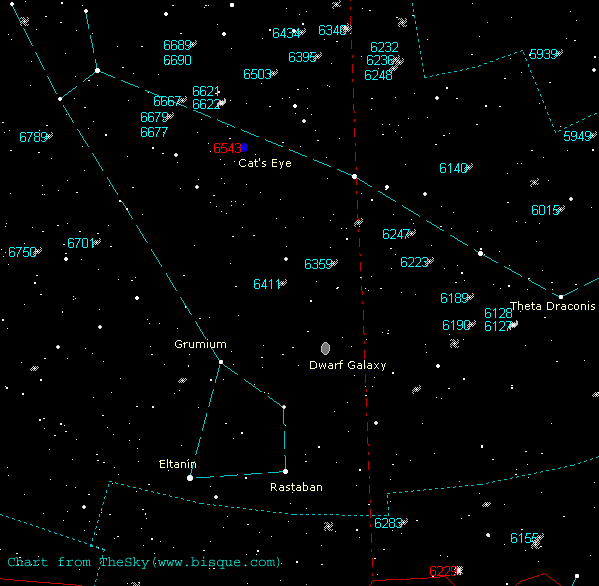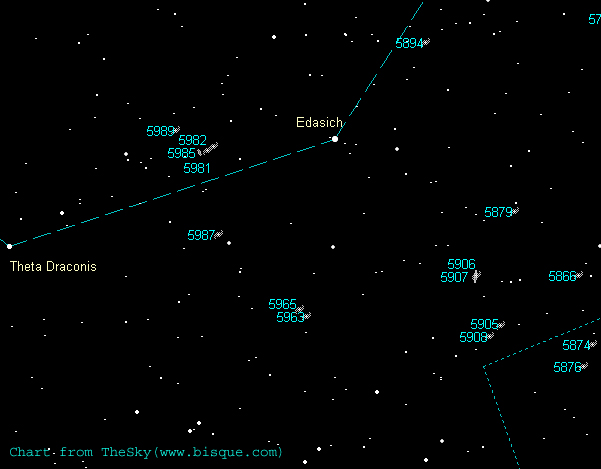Draco The Dragon
The northern sky is home to a pair of very familiar bears namely Ursa Major and Ursa Minor, more commonly known as the Big and Little Dipper. Residing so high in northern skies these constellations are referred to as circumpolar; they are never lost below the horizon and can be seen on any clear night of the year from Canadian soil. However, lurking in a lengthy area between the two bears is Draco the Dragon. Its long body slithers and coils to claim 1,083 square degrees of sky. At first glance, you would think that this mammoth constellation ranks first in area but with an extra 220 square degrees, that distinction lies with Hydra low in the southern hemisphere. Draco ranks eighth place.
During the past months we have looked at many galaxies belonging to Virgo with the swarm continuing north through Coma Berenices, Canes Venatici, Ursa Major and now we end up at Draco. Many of these distant objects have elongated structures with even a few of the edge-on variety. No less than fourteen stars make up the Dragon’s asterism which begins with its head situated above the constellation Hercules.

We presently refer to Polaris as the North or Pole Star. Such has not always the case. If we can go back in time to around the year 2700 BC, we would see Thuban (alpha Draconis) was the North Star for that time period. The northern reference point slowly changes during the 26,000-year precession of Earth’s axis. Just as a spinning top slows down, its axis begins to wobble. Since Earth’s axis is tilted 23.5 degrees, the circle of precession also measures 23.5 degrees wide and takes them 26,000 years to complete one revolution. In fact, the star Vega will be somewhat the North Star reference point some 12,000 years from now. The same polar shift also occurs in the southern hemisphere.
Thuban is a magnitude 3.8 giant star located 310 light-years from us and appears to harbour an unseen companion that orbits every 51 days. Thuban is a white giant star of spectral class A0. Its surface temperature registers at 9800 Kelvin but shines a rare five times brighter than what it should be and 300 times more luminous than our Sun.
Now move eleven degrees to Edasich which is a K2 giant located 101 light-years away. Edasich is one of the ten stars in Draco that have at least one orbiting extrasolar planet. Discovered in 2001, Iota Draconis b has the mass 8.9 times that of Jupiters and orbits once every 536 days.
Within three degrees in almost any direction from this parent star are some great targets For example, halfway between Iota and Theta Draconis is a fantastic group of elongated structures. They are NGC 5981, 5982, and 5985 with magnitudes of 13.2, 11.0 and 11.1 respectively. Their distances from us are estimated to be 96, 135 and 143 million light-years. Another beauty is NGC 5907 also known as the Splinter or Knife Galaxy. This edge-on is only 40 million light-years and glows at magnitude 10.4. Measuring 13 arc minutes in length and 1.4 arc minutes in width, NGC 5907 is a must to hunt down and image.
One of the Hubble Space Telescope’s targets was the Cat’s Eye Nebula. NGC 6543 is a planetary nebula that lies 3,600 light-years from us with a magnitude of 8.1. There is a strange structure to the remains of the central dead star. The theoretical cause is what was thought to be one central star is actually a binary star system. You should also notice NGC 6552 which is a 14th magnitude spiral galaxy some nine arc minutes from the Cat’s Eye and 50 million light-years from Earth. Now for a real challenge try is to spot and photograph the Draco Dwarf Galaxy. At only 260,000 light-years away, this dwarf elliptical measures 33 by 19 arc minutes or a full moon in width and is considered a companion of the Milky Way Galaxy. Good luck with that one.

Deemed the best meteor shower of the year – the Perseids will be at their best on the morning of August 12th. With an estimated rate of 100 meteors per hour, the moon will rise around midnight thus being a nuisance. But even with the Moon up, it should still be worth a trip to the country with a clear horizon. Speaking of the Moon, there will be two full moons slated for August 1st – the Sturgeon Moon and on the 31st – the Grain Moon which is also the Blue Moon. The Moon will not turn blue or will it?
The summer of 1950 was extremely dry and there were massive forest fires burning in the west. Famed Canadian astronomer Helen Sawyer Hogg was living in Southern Ontario at the time of the fires. On September 25 and 26 heavy smoke filled the air and by 3:30 p.m. it seemed like nightfall. At times she could see the Sun briefly come into view and appeared blue-mauve in colour but casting no shadows. She explained at the time was most likely caused by certain types of dust particles that are slightly larger than a wavelength of light. These particles filter red light but allow blue light to pass through, thereby creating the illusion of a blue moon and sun. The days that followed, eastern Canada and the US and eventually the British Isles saw the same phenomena.
This month’s new Moon is slated for the 17th. Since we are now in cottage and camping season, try to plan your getaway time around this date to take advantage of country skies and the absence of light pollution. The Milky Way will be riding high overhead as it stretches to the south to Sagittarius and the middle of our galaxy. Unfortunately, you will be without bright planets for most of the night as Mars sets at 11:00 p.m. locally on the 1st and Saturn sinks below the horizon a half-hour later. On the 14th, Saturn, Mars and Spica line up nicely, thus another digital moment very low in the west. During the night you will have to hunt for the planets Neptune in Aquarius and Uranus in Cetus. Come the morning Venus and Jupiter blaze away in the east before sunrise.
Until next month, clear skies everyone.
